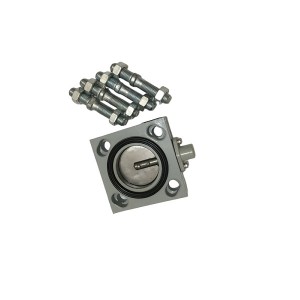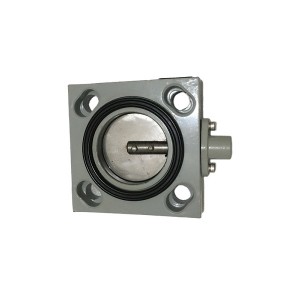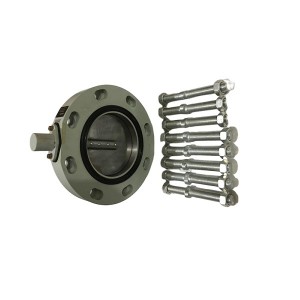In the complex system of thermal power plants, valves, as one of the key equipment, bear the important responsibility of controlling the flow of media and ensuring the safety of the system. Among them, the stainless steel sandwich rubber lined butterfly check valve DH71X-10 is widely used in high temperature, high pressure and corrosive media environments due to its unique structural design and excellent performance. However, the maintenance of the rubber layer, the core component of this type of valve, is directly related to its sealing, durability and the stable operation of the entire system. Now we will focus on the maintenance precautions of the rubber layer of the butterfly check valve, and combine it with the actual application scenarios to explore how to extend the life of the equipment and improve the operating efficiency through scientific maintenance strategies.
1. The importance of rubber layer function and maintenance
The rubber layer of the stainless steel sandwich rubber lined butterfly check valve DH71X-10 is the core component of its sealing performance. The rubber layer is usually made of corrosion-resistant and aging-resistant rubber material, and the one-way flow control of the medium is achieved by closely fitting the contact surface between the valve body and the valve disc. In thermal power plants, this type of butterfly check valve is often used in key links such as boiler feed water systems, steam delivery pipelines and cooling water circulation systems. Due to the high temperature and pressure of the medium, and the possibility of containing particulate matter or chemically corrosive components, the rubber layer is in complex working conditions for a long time, and is prone to aging, wear or deformation. If the rubber layer is not properly maintained, it may lead to seal failure, medium leakage or even system shutdown accidents, which directly affects the economic benefits and safe operation of the power plant.

Therefore, for the maintenance of the rubber layer of the butterfly check valve DH71X-10, a systematic management process must be established, from daily inspection to special maintenance, to ensure that the rubber layer is always in the best working condition. This not only requires operators to master professional skills, but also requires the development of scientific maintenance plans based on the characteristics of equipment operation.
2. Key links in daily maintenance
In daily operation, the maintenance of the rubber layer of the butterfly check valve DH71X-10 should be based on preventive measures, focusing on cleaning, lubrication and sealing performance testing. First of all, cleaning is the basis of maintenance work. Since impurities or corrosive particles are often mixed in the medium of thermal power plants, these substances may adhere to the surface of the rubber layer, causing local wear or blockage. Regularly cleaning the sediments on the inner wall of the valve body and the surface of the rubber layer can effectively reduce friction resistance and extend the service life of the rubber layer. Neutral detergents should be used for cleaning to avoid secondary damage to the rubber material caused by strong acids and alkalis.
Secondly, lubrication is an important part of ensuring the flexible operation of the rubber layer. Although the rubber layer itself has a certain elasticity, its moving parts may still age faster due to dry friction under frequent opening and closing or high temperature environments. It is recommended to select lubricants compatible with rubber materials according to the technical specifications provided by the manufacturer and apply them to the moving parts regularly. It should be noted that the amount of lubricant should not be too much to prevent residues from clogging the gaps in the rubber layer or causing medium contamination.
Sealing performance testing is the core content of daily maintenance. By regularly observing whether the DH71X-10 valve body has signs of leakage, or using pressure testing equipment to simulate actual working conditions, minor defects in the rubber layer can be discovered in time. For example, if medium leakage is detected in the closed state, it may indicate scratches or compression deformation on the surface of the rubber layer. At this time, it is necessary to combine manual inspection and comprehensively analyze the root cause of the problem. For minor wear, the sealing can be restored by grinding or local repair; if the damage is serious, the rubber layer needs to be replaced to avoid risk accumulation.

3. Maintenance strategies under special environments
The operating environment of thermal power plants is complex and changeable. The maintenance strategy of the rubber layer of the butterfly check valve DH71X-10 needs to be adjusted according to the specific working conditions. For example, in a high-temperature steam system, the rubber layer is exposed to a temperature above 150°C for a long time, and the rubber material may accelerate hardening or lose elasticity. At this time, in addition to routine cleaning and lubrication, it is also necessary to focus on the thermal stability of the rubber layer. It is recommended to use rubber materials with high temperature resistance grades and reserve appropriate thermal expansion gaps during installation to adapt to the deformation caused by temperature changes.
In addition, if the working medium of the butterfly valve contains corrosive components such as chloride ions or sulfides, the rubber layer is prone to chemical degradation. During maintenance, it is necessary to strengthen the monitoring of corrosive media, regularly sample and analyze the concentration of its components, and adjust the protective measures of the rubber layer according to the results. For example, in a highly corrosive environment, an anti-corrosion coating can be applied to the surface of the rubber layer or a protective gasket can be added to isolate the direct contact between the medium and the rubber substrate. At the same time, the cycle of sealing performance testing needs to be shortened to ensure early detection of potential risks.
4. Operation Specifications and Fault Prevention
The implementation of operation specifications is the key to ensure the long-term stable operation of the rubber layer of the butterfly check valve DH71X-10. During the opening and closing process of the valve, the operator should avoid violent operation, especially the closing action should be slow and uniform to prevent the rubber layer from cracking due to excessive impact force. In addition, the butterfly check valve must be installed strictly in accordance with the flow direction arrow marked on the equipment nameplate to ensure that the flow direction of the medium is consistent with the design requirements, otherwise the rubber layer may be abnormally worn due to reverse flow.
For DH71X-10 butterfly check valves that have been out of service for a long time, special measures must be taken for the maintenance of the rubber layer. Before deactivation, the inside of the valve body should be thoroughly cleaned and anti-rust oil or sealing protective agent should be applied to prevent the rubber layer from becoming brittle due to drying or oxidation. When reactivating, a manual operation test must be performed first to confirm that the rubber layer is flexible before it is put into formal operation. If adhesion or jamming of the rubber layer is found, a special solvent can be used to gently wipe the surface, or low-pressure medium can be passed in for a short time for flushing to gradually restore its elasticity.
In terms of fault prevention, a complete inspection system needs to be established. Inspection personnel should regularly record the degree of wear of the rubber layer, changes in sealing performance and operational feedback to form a dynamic maintenance file. For example, a thermal power plant found that the rubber layer of a butterfly check valve had local bulges during routine inspections. After analysis, it was found that it was caused by long-term friction of medium particles. By replacing the rubber layer in advance, subsequent leakage accidents that may be caused were avoided. Such experience shows that detailed inspection records and data analysis are important means to prevent failures.

When looking for high-quality, reliable butterfly valves, YOYIK is undoubtedly a choice worth considering. The company specializes in providing a variety of power equipment including steam turbine accessories, and has won wide acclaim for its high-quality products and services. For more information or inquiries, please contact the customer service below:
E-mail: sales@yoyik.com
Tel: +86-838-2226655
Whatsapp: +86-13618105229
Yoyik offers various types of power plants spare parts for steam turbines, generators, boilers as below:
Pressure Relief Valve Ysf16-55/80Kkj
Bonnet Gasket Z942H-16C
Yx Type Seal Ring D280
Piston Seals Gsf 9500
Bearing Elements Gst 5930-D950
Solenoid Valve Body 1-24-Dc-16 24102-12-4R-B13
Installation Screen By Switching Piece Jl1-2.5/2
Vavle V38577
Valve 73218Bn4Unlvnoc111C2
Manifold Block For Opc Solenoid Valve 4420197142
O Type Seal Ring 280X7.0
“O” Type Seal Ring Hn 7445-250X7.0
“O” Type Seal Ring Hn 7445-38.7X3.55
“O” Type Seal Ring Hn 7445-75.5X3.55
Dc Sealing Oil Pump Bushing Kg70Kz/7.5F4
Circulating Oil Pump Kg70Ky/7.5F4
Oil Circulation Pump F3-V10-1S6S-1C20
Fuel Supply Device Test Solenoid Valve 22Fda-K2T-W220R-20/Lv
Deh System Solenoid Valve 4We10D33/Cg220N9K4/V
12 Volt Hydraulic Directional Control Valves 4We10D33/Cw230N9K4/V
Pressure Control Valve Hf02-02-01Y
Vacuum Cylinder Pump L-110
Vacuum Pump P-2811
Vacuum Pump Spare Parts Flash Board Er207-20
Two Stage Liquid Ring Vacuum Pump P-1741
Vacuum Pump Principle P-1761
High Vacuum Pump P-1764-1
Post time: Jun-12-2025













